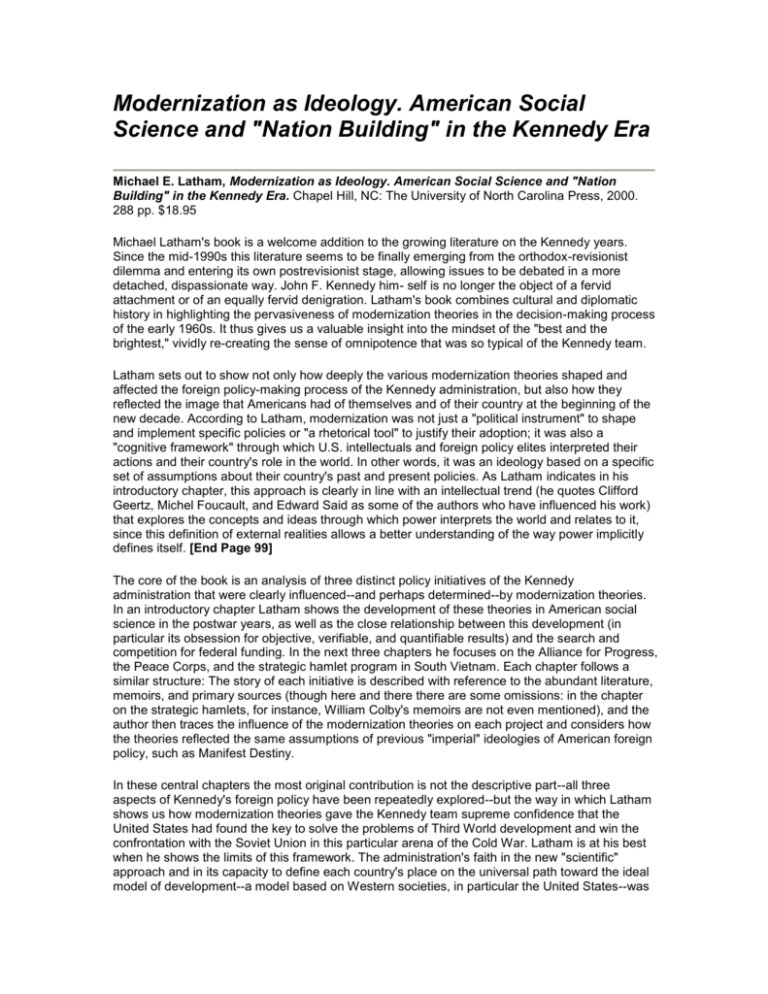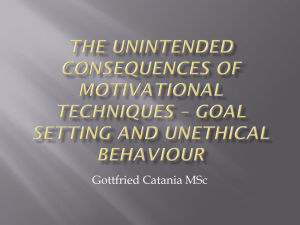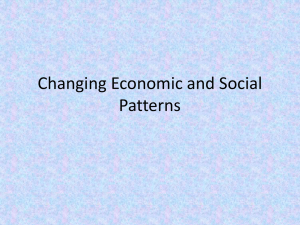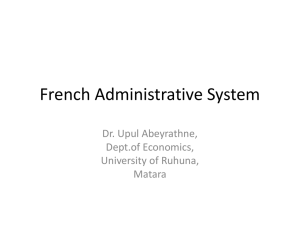Modernization as Ideology. American Social Science and "Nation
advertisement

Modernization as Ideology. American Social Science and "Nation Building" in the Kennedy Era Michael E. Latham, Modernization as Ideology. American Social Science and "Nation Building" in the Kennedy Era. Chapel Hill, NC: The University of North Carolina Press, 2000. 288 pp. $18.95 Michael Latham's book is a welcome addition to the growing literature on the Kennedy years. Since the mid-1990s this literature seems to be finally emerging from the orthodox-revisionist dilemma and entering its own postrevisionist stage, allowing issues to be debated in a more detached, dispassionate way. John F. Kennedy him- self is no longer the object of a fervid attachment or of an equally fervid denigration. Latham's book combines cultural and diplomatic history in highlighting the pervasiveness of modernization theories in the decision-making process of the early 1960s. It thus gives us a valuable insight into the mindset of the "best and the brightest," vividly re-creating the sense of omnipotence that was so typical of the Kennedy team. Latham sets out to show not only how deeply the various modernization theories shaped and affected the foreign policy-making process of the Kennedy administration, but also how they reflected the image that Americans had of themselves and of their country at the beginning of the new decade. According to Latham, modernization was not just a "political instrument" to shape and implement specific policies or "a rhetorical tool" to justify their adoption; it was also a "cognitive framework" through which U.S. intellectuals and foreign policy elites interpreted their actions and their country's role in the world. In other words, it was an ideology based on a specific set of assumptions about their country's past and present policies. As Latham indicates in his introductory chapter, this approach is clearly in line with an intellectual trend (he quotes Clifford Geertz, Michel Foucault, and Edward Said as some of the authors who have influenced his work) that explores the concepts and ideas through which power interprets the world and relates to it, since this definition of external realities allows a better understanding of the way power implicitly defines itself. [End Page 99] The core of the book is an analysis of three distinct policy initiatives of the Kennedy administration that were clearly influenced--and perhaps determined--by modernization theories. In an introductory chapter Latham shows the development of these theories in American social science in the postwar years, as well as the close relationship between this development (in particular its obsession for objective, verifiable, and quantifiable results) and the search and competition for federal funding. In the next three chapters he focuses on the Alliance for Progress, the Peace Corps, and the strategic hamlet program in South Vietnam. Each chapter follows a similar structure: The story of each initiative is described with reference to the abundant literature, memoirs, and primary sources (though here and there there are some omissions: in the chapter on the strategic hamlets, for instance, William Colby's memoirs are not even mentioned), and the author then traces the influence of the modernization theories on each project and considers how the theories reflected the same assumptions of previous "imperial" ideologies of American foreign policy, such as Manifest Destiny. In these central chapters the most original contribution is not the descriptive part--all three aspects of Kennedy's foreign policy have been repeatedly explored--but the way in which Latham shows us how modernization theories gave the Kennedy team supreme confidence that the United States had found the key to solve the problems of Third World development and win the confrontation with the Soviet Union in this particular arena of the Cold War. Latham is at his best when he shows the limits of this framework. The administration's faith in the new "scientific" approach and in its capacity to define each country's place on the universal path toward the ideal model of development--a model based on Western societies, in particular the United States--was so strong that whenever a program ran into adversity and there were clear signs of impending difficulties, those difficulties were blamed not on the program itself but on the way it was managed and implemented or on the inherent limitations of the native populations whose problems were supposed to be solved. Hence came the allegations of "lethargic leadership" (p. 106) in Latin America, corruption in South Vietnam, and overextension. The other interesting aspect of the book is its exploration of the implicit ideological assumptions of modernization, of how it projected the image of an altruistic, benevolent--yet tough, energetic, and determined--U.S. foreign policy and a similar image of the American people in general. As such, the author points out, modernization clearly reflected the same basic principles that had shaped previous "imperial" ideologies, in spite of the firm American conviction that U.S. policy toward the less-developed countries was completely different from the imperial experiences of the European powers. Latham has clearly succeeded in providing us with a vivid rendition of the influence of modernization theories and the firm grip they had for a while on U.S. policy makers. There are other cases that the book does not mention in which it is possible to trace the same urge to prod a foreign ally to the next stage of development: from the mild encouragement of the White Revolution in Iran to the convoluted support [End Page 100] for the "opening to the Left" in Italy. If some minor criticisms can be advanced, they are related to the structure of the book, which in its rigid division and urge to prove its thesis sometimes leads to oversimplification and repetitiveness. In at least one case, Latham forces events into an interpretative straitjacket that leaves out some significant nuances. As Jefferson Marquis has shown, U.S. nation building in Vietnam was not based just on modernization theories; it also rested on at least three different cultural/political approaches, two of which were quite skeptical of any attempt to modernize rural Vietnamese society (see Jefferson P. Marquis, "The Other Warriors: American Social Science and Nation Building in Vietnam," Diplomatic History, Vol. 24, No. 1, Winter 2000, pp. 79-105). To avoid repetition, perhaps it would have been better if Latham had explored the diffusion and circulation of modernization theories inside the Kennedy administration in a straight forward chronological order, tracing their success. He could have then discussed their relationship to previous American ideologies in greater depth in a concluding chapter, rather than doing so after each case. Nonetheless, these shortcomings do not detract from the value of the book, which remains an insightful, important contribution to our understanding of American foreign policy in the Kennedy years and the cultural assumptions of U.S. foreign policy more generally. Reviewed by Leopoldo Nuti, University of Roma Tre (Italy)





